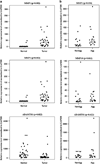Differential expression of degradome components in cutaneous squamous cell carcinomas
- PMID: 24356192
- PMCID: PMC4251465
- DOI: 10.1038/modpathol.2013.217
Differential expression of degradome components in cutaneous squamous cell carcinomas
Abstract
Although the cure rate for cutaneous squamous cell carcinoma is high, the diverse spectrum of squamous cell carcinoma has made it difficult for early diagnosis, particularly the aggressive tumors that are highly associated with mortality. Therefore, molecular markers are needed as an adjunct to current staging methods for diagnosing high-risk lesions, and stratifying those patients with aggressive tumors. To identify such biomarkers, we have examined a comprehensive set of 200 histologically defined squamous cell carcinoma and normal skin samples by using a combination of microarray, QRT-PCR and immunohistochemistry analyses. A characteristic and distinguishable profile including matrix metalloproteinase (MMP) as well as other degradome components was differentially expressed in squamous cell carcinoma compared with normal skin samples. The expression levels of some of these genes including matrix metallopeptidase 1 (MMP1), matrix metallopeptidase 10 (MMP10), parathyroid hormone-like hormone (PTHLH), cyclin-dependent kinase inhibitor 2A (CDKN2A), A disintegrin and metalloproteinase with thrombospondin motifs 1 (ADAMTS1), FBJ osteosarcoma oncogene (FOS), interleukin 6 (IL6) and reversion-inducing-cysteine-rich protein with kazal motifs (RECK) were significantly differentially expressed (P≤0.02) in squamous cell carcinoma compared with normal skin. Furthermore, based on receiver operating characteristic analyses, the mRNA and protein levels of MMP1 are significantly higher in aggressive tumors compared with non-aggressive tumors. Given that MMPs represent the most prominent family of proteinases associated with tumorigenesis, we believe that they may have an important role in modulating the tumor microenvironment of squamous cell carcinoma.
Conflict of interest statement
The authors declare no conflict of interest.
Figures

 , transcription factor;
, transcription factor;  , generic enzyme;
, generic enzyme;  , generic phospholipase;
, generic phospholipase;  , protein kinase;
, protein kinase;  , generic protease;
, generic protease;  , metalloprotease;
, metalloprotease;  , receptor ligand;
, receptor ligand;  , generic receptor;
, generic receptor;  , receptor with enzyme activity;
, receptor with enzyme activity;  , GPCR;
, GPCR;  , proteoglycan;
, proteoglycan;  , generic-binding protein;
, generic-binding protein;  , generic channel). Red lines are inhibitory interactions, green lines are activating and gray indicate an unspecified effect in the source literature. Red and blue circles indicate genes upregulated or downregulated, respectively, in tumors compared with normal skin. Note MMP1, MMP10 (stromelysin-2) and ADAM-TS1 are shown in ‘dashed circles’ to indicate the expression pattern and their association with other differentially expressed genes.
, generic channel). Red lines are inhibitory interactions, green lines are activating and gray indicate an unspecified effect in the source literature. Red and blue circles indicate genes upregulated or downregulated, respectively, in tumors compared with normal skin. Note MMP1, MMP10 (stromelysin-2) and ADAM-TS1 are shown in ‘dashed circles’ to indicate the expression pattern and their association with other differentially expressed genes.



Similar articles
-
Expression profiles and clinical correlations of degradome components in the tumor microenvironment of head and neck squamous cell carcinoma.Clin Cancer Res. 2010 Apr 1;16(7):2022-35. doi: 10.1158/1078-0432.CCR-09-2525. Epub 2010 Mar 21. Clin Cancer Res. 2010. PMID: 20305301
-
Expression of reversion-inducing cysteine-rich protein with kazal motifs and matrix metalloproteinase 9 in middle ear squamous cell carcinoma.ORL J Otorhinolaryngol Relat Spec. 2012;74(1):16-21. doi: 10.1159/000334243. Epub 2011 Dec 16. ORL J Otorhinolaryngol Relat Spec. 2012. PMID: 22178867
-
Matrix metalloproteinase 1: a better biomarker for squamous cell carcinoma by multiple microarray analyses.G Ital Dermatol Venereol. 2019 Jun;154(3):327-337. doi: 10.23736/S0392-0488.17.05770-4. Epub 2017 Dec 15. G Ital Dermatol Venereol. 2019. PMID: 29249121
-
Differential expressions of matrix metalloproteinases, a disintegrin and metalloproteinases, and a disintegrin and metalloproteinases with thrombospondin motifs and their endogenous inhibitors among histologic subtypes of lung cancers.Anticancer Agents Med Chem. 2012 Sep;12(7):744-52. doi: 10.2174/187152012802650156. Anticancer Agents Med Chem. 2012. PMID: 22292754 Review.
-
MicroRNA Dysregulation in Cutaneous Squamous Cell Carcinoma.Int J Mol Sci. 2019 May 2;20(9):2181. doi: 10.3390/ijms20092181. Int J Mol Sci. 2019. PMID: 31052530 Free PMC article. Review.
Cited by
-
MicroRNA31 and MMP-1 contribute to the differentiated pathway of invasion -with enhanced epithelial-to-mesenchymal transition- in squamous cell carcinoma of the skin.Arch Dermatol Res. 2022 Oct;314(8):767-775. doi: 10.1007/s00403-021-02288-x. Epub 2021 Oct 13. Arch Dermatol Res. 2022. PMID: 34647185
-
Role of Matrix Metalloproteinases in Photoaging and Photocarcinogenesis.Int J Mol Sci. 2016 Jun 2;17(6):868. doi: 10.3390/ijms17060868. Int J Mol Sci. 2016. PMID: 27271600 Free PMC article. Review.
-
The Genomic Landscape of Actinic Keratosis.J Invest Dermatol. 2021 Jul;141(7):1664-1674.e7. doi: 10.1016/j.jid.2020.12.024. Epub 2021 Jan 19. J Invest Dermatol. 2021. PMID: 33482222 Free PMC article.
-
Assessment of Inflammation in 3D Reconstructed Human Skin Exposed to Combined Exposure to Ultraviolet and Wi-Fi Radiation.Int J Mol Sci. 2023 Feb 2;24(3):2853. doi: 10.3390/ijms24032853. Int J Mol Sci. 2023. PMID: 36769173 Free PMC article.
-
TLR4 as a negative regulator of keratinocyte proliferation.PLoS One. 2017 Oct 5;12(10):e0185668. doi: 10.1371/journal.pone.0185668. eCollection 2017. PLoS One. 2017. PMID: 28982115 Free PMC article.
References
-
- Rogers HW, Weinstock MA, Harris AR, et al. Incidence estimate of nonmelanoma skin cancer in the United States, 2006. Arch Dermatol. 2010;146:283–287. - PubMed
-
- Diepgen TL, Mahler V. The epidemiology of skin cancer. Br J Dermatol. 2002;146(Suppl 61):1–6. - PubMed
-
- Housman TS, Feldman SR, Williford PM, et al. Skin cancer is among the most costly of all cancers to treat for the Medicare population. J Am Acad Dermatol. 2003;48:425–429. - PubMed
-
- Housman TS, Williford PM, Feldman SR, et al. Non-melanoma skin cancer: an episode of care management approach. Dermatol Surg. 2003;29:700–711. - PubMed
-
- Alam M, Ratner D. Cutaneous squamous-cell carcinoma. N Engl J Med. 2001;344:975–983. - PubMed
MeSH terms
Substances
Grants and funding
LinkOut - more resources
Full Text Sources
Other Literature Sources
Medical
Research Materials
Miscellaneous

